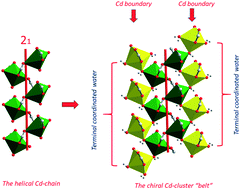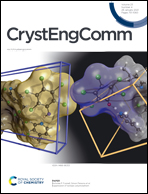A nonlinear optical cadmium(ii)-based metal–organic framework with chiral helical chains derived from an achiral bent dicarboxylate ligand†
Abstract
The design of nonlinear optical (NLO) MOF (metal–organic framework) materials from a nonchiral ligand is of fundamental interest, both chemically and for industrial applications. In this work, an NLO Cd(II)-based metal–organic framework [Cd2(TDB)2(H2O)3]n (1) was synthesized from the reaction of Cd(II) salts and a new bent ligand, 2,5-(thiophenediyl)dibenzoic acid (H2TDB) under hydrothermal conditions. The structure of compound 1 was spectroscopically characterized, and further confirmed by single-crystal X-ray diffraction analysis. Compound 1 crystallized in the monoclinic chiral space group P21. The bent TDB ligand exhibited unsymmetrical coordination behavior with chelating and monodentate carboxylate coordination modes on each side towards two Cd metal centers, thus permitting the formation of helical Cd chains along the crystallographic 21 screw-axis. These chiral helical Cd chains are further linked by Cd(2) ions to form a Cd-cluster belt, leading to the formation of a novel “quadruple-deck” network, which is reported for the first time. This unique structural arrangement is so special that it leads to unusual non-linear optical properties with a strong second harmonic generation (SHG) response. The value is about 40 times that of SiO2, as indicated by circular dichroism (CD) measurements. In addition to its high thermal and chemical stability, the chiral and non-centrosymmetric nature of 1 makes it a suitable candidate for NLO applications.

- This article is part of the themed collection: Coordination Networks


 Please wait while we load your content...
Please wait while we load your content...